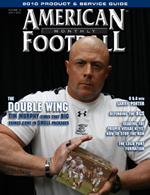Article CategoriesAFM Magazine
|
Speed Report: Mechanical Application & Technique-The Backbone for Football Speed Developmentby: Dale BaskettFootball Speed Specialist © More from this issue All human movement must be viewed as a mechanical function. The faster the movement, the greater the potential for a mechanical breakdown. Athletic movement at high velocity levels requires precise mechanical execution. Also important is the motor pattern development which needs to be a target from a spontaneity standpoint. For whatever mechanical function is utilized, it is being recorded as muscle firing memorization. What patterns used become ingrained and fire directly the same way over and over again. This is why it is very important to understand the methods of movement that are correct so as to prevent improper input. The mind doesnít decipher the incoming information; it just records it. The athlete and coach must decipher the correct material thatís loaded into the computer. It is critical that you use the proper biomechanical....The full article can only be seen by subscribers.
|
|
|||||||
| HOME |
MAGAZINE |
SUBSCRIBE | ONLINE COLUMNISTS | COACHING VIDEOS |
Copyright 2025, AmericanFootballMonthly.com
All Rights Reserved





